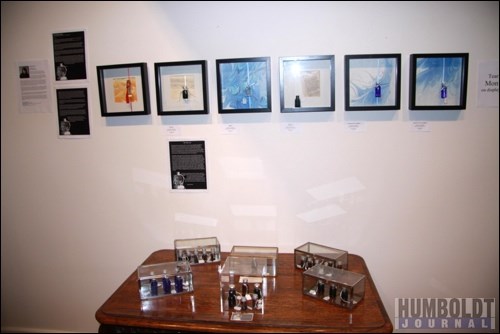"I hope people will realize the power of tears," said Saskatoon artist Monique Martin, whose exhibit, Tear Room Project is currently on display at the Humboldt and District Museum and Gallery (HDMG).
Martin has put together a collection of 41 jars of tears displayed in six tabletop boxes and six shadow boxes.
Each jar is tagged with a short description regarding the source of the tears.
"We are a career driven society," said Martin, "But it is very rare that we cry about our careers. It is the relationships that are the main source of our tears."
The idea for the collection came from Martin seeing a tear vial a number of years ago when she was in England. She learned its history and became inspired.
"I travel a lot so I see a lot of tears in airports," she said. "Those moments are very powerful."
She has collected the show's exhibits over a number of years with approximately another 25 in her home. Despite not distributing bottles for a while now, she still receives some through the mail.
"I handed out tear jars on planes and trains, just about everywhere I travelled," she said. "I also gave them a piece of paper explaining the history of the tear vial, the purpose of the jar, how to collect the tears and where to send it."
She also used her website and blog to put the word out about the tear vials.
HDMG staff, including curator Jennifer Hoesgen and programmer Anneka Drinkwater, both contributed jars to the exhibit.
Each of the bottles is labelled when she receives it, but they do not always carry a name. For example, she received a jar that bore the one-word label -- lump. While some are simply one word, others are accompanied by a story.
One such story is that of Trudy McKinnon's experience with tear jars. For McKinnon it began as a baby food jar and a means of distraction for her oldest daughter who was strong-willed at the early age of one. To avoid a temper tantrum or crisis, McKinnon would encourage her daughter to get the jar and they would attempt to capture the tears off her chubby baby cheeks. This was just one of the happy memories McKinnon shares with her daughter.
"In the show is a jar labelled 'dragon'," said Martin. "They are tears collected on January 23 - the Chinese New Year. It is believed that genuine tears from that day can be made into medicine."
This is just one of the things Martin has learned from the process.
There is an engaged couple who is going to receive a very special gift from Martin on their wedding day. It is the tear vial labelled "Oceans Apart." The young man was living in Belgium and the young lady in Saskatoon. The tear vial traversed the ocean a number of times as the pair travelled to each other. The vial was given to Martin last Christmas when he decided he was not returning to Belgium, they became engaged and there no longer was a need for the vial, as there would no longer be an ocean between them.
"They are very powerful stories," she said.
Another interesting tidbit Martin learned while compiling the collection was how people were simply not aware of how often they cried.
Because of this, she is looking at a future project tentatively entitled Kiss and Cry, capturing interactions at airports.
"That moment of parting can be very emotional," she said.
As for the Tear Room Project, Martin simply hopes each visitor will find something in her work that touches him or her individually.




